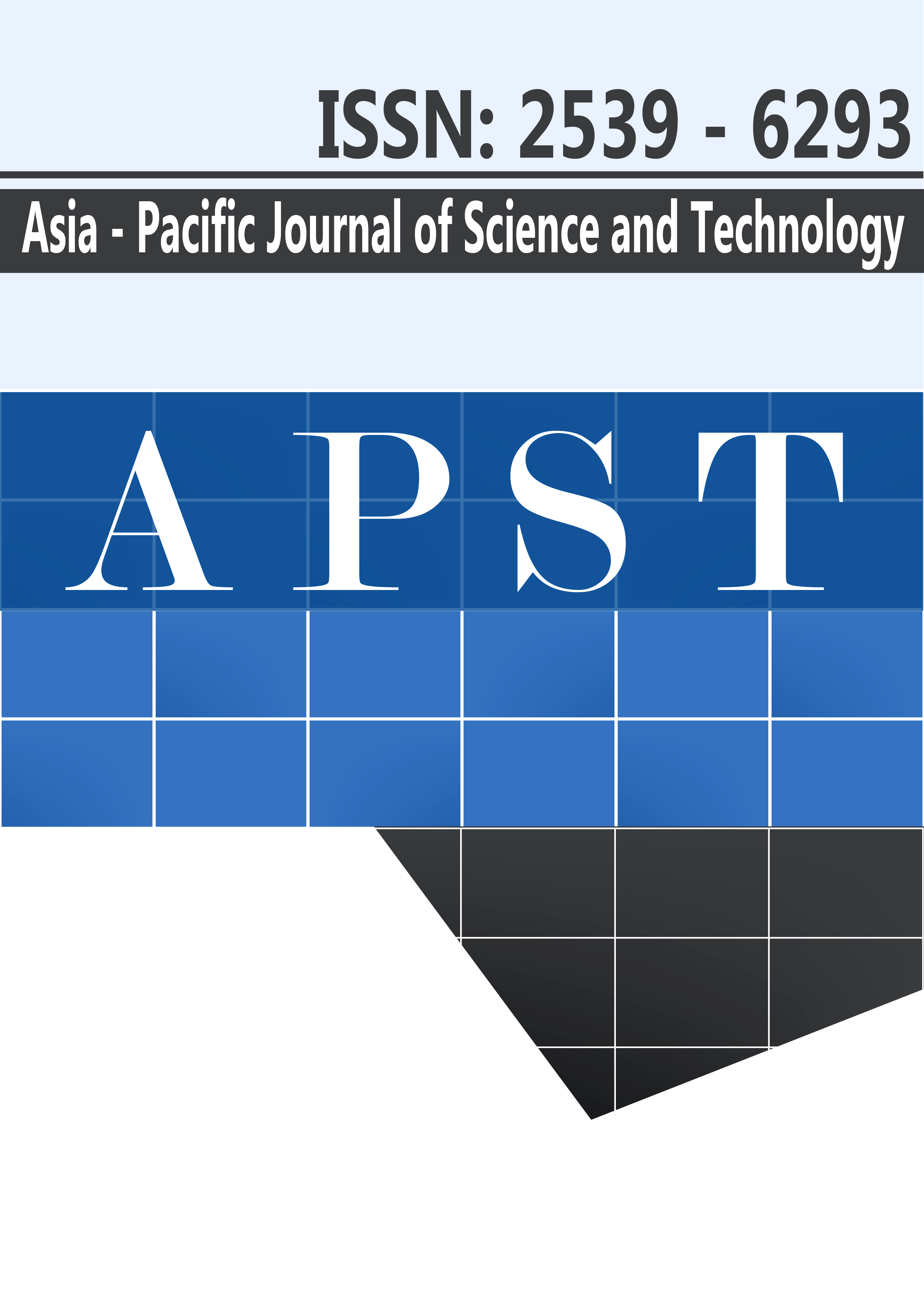The effect of Indian marsh fleabane (Pluchea indica (L.) Less) dried leaves extract against oxidative stress induced by hydrogen peroxide in Saccharomyces cerevisiae
Main Article Content
Abstract
The objective of this research was to assess the potential antioxidative capacity of Indian marsh fleabane (Pluchea indica (L.) Less) dried leaves extract. The extract was investigated the content of major groups of antioxidants, radical scavenging capacity and the effect against oxidative stress which was induced by hydrogen peroxide in Saccharomyces cerevisiae. The results showed that the extract had high concentration of antioxidants; total phenolic compounds (84.691.56 mg GAE/g dry weight), total tannins (69.63
0.39 mg TAE/g dry weight) and total flavonoids (45.15
1.08 mg QUE/g dry weight). The extract showed high DPPH radical scavenging activity (IC50 = 0.04
0.00 mg/ml extract and TEAC = 81.04
0.55 mg TE/g dry weight). Cellular antioxidative stress activity of the extract was determined against the stationary phase S. cerevisiae TISTR 5240 which was induced to be stressed by hydrogen peroxide (H2O2) at IC50 concentration (1.88 mM). The results revealed that the highest survival rate of S. cerevisiae was at 100
g/ml of the extract (%survival = 60.74
1.12) or 3/4 fold with respected to that of 50 μg/ml standard quercetin (%survival = 83.11
0.89). Survival rate of S. cerevisiae at the concentrations between 5.00–25.00
g/ml were significantly lower (p<0.05) compared with the control, while that of 50.00 g/ml of the extract and the control were not significant difference (p>0.05). These concentrations might be too low to scavenge free radicals. However, survival of yeast cells slightly increased with increasing the concentration of the extract pretreated to the cells. Importantly, survival rate of S. cerevisiae was significantly decreased when they were incubated with 500 and 1,000.00
g/ml of the extract due to the toxicity of the extract to the cell. From the results, P. indica dried leaves extract had high antioxidant capacity and showed antioxidant activity against H2O2 at the cellular level or cytoprotective effects. Thus, dried leaves from P. indica may be developed to the herbal tea recommended to the consumers for potential preventing the diseases caused by oxidative stress.
Article Details
References
Lushchak VI. Budding yeast Saccharomyces cerevisiae as a model to study oxidative modification of proteins in eukaryotes–review. Acta Biochim Pol. 2006;53(4):679-84.
López-Alarcón C, Denicola A. Evaluating the antioxidant capacity of natural products: a review on chemical and cellular-based assays. Anal Chim Acta. 2013;763:1-10.
Roslida A, Erazuliana A, Zuraini A. Anti-inflammatory and antinociceptive activities of the ethanolic extract of Pluchea indica (L.) Less leaf. Pharmacologyonline. 2008;2:349–60.
Cho J, Cho CL, Kao CL, Chen CM, Tseng CN, Lee YZ, Liao LJ, Hong YR. Crude aqueous extracts of Pluchea indica (L.) Less inhibit proliferation and migration of cancer cells through induction of P53-dependent cell death. BMC Complement Altern Med. 2012;12(1):265.
Biswas R, Dutta PK, Achari B, Bandyopadhyay D, Mishra M, Pramanik KC, Chatterjee TK. Isolation of pure compound R/J/3 from Pluchea indica (L.) Less and its anti-amoebic activities against Entamoeba histolytica. Phytomedicine. 2007;14:534–7.
Andarwulan N, Batari R, Agustini D, Bolling B, Wijaya H. Flavonoid content and antioxidant activity of vegetables from Indonesia. Food Chem. 2010;121:1231–5.
Pinitsoontorn C, Suwantrai S, Boonsiri P. Antioxidant activity and oxalate content of selected Thai herbal teas. KKU Res J. 2012;17(1):162–8.
Srisook K, Buapool D, Boonbai R, Simmasut P, Charoensuk Y, Srisook E. Antioxidant and anti-inflammatory activities of hot water extract from Pluchea indica Less herbal tea. J Med Plants Res. 2012;6(23):4077–81.
Ahemd SA, Kamel EM. Phenolic constituents and biological activity of the genus Pluchea. Der Pharma Chem. 2013;5(5):109–14.
Srimoon R., Ngiewthaisong S. Antioxidant and antibacterial activities of Indian marsh fleabane (Pluchea indica (L.) Less). KKU Res J. 2015;20(2):144-54.
Carmona-Gutierrez D, Eisenberg T, Büttner S, Meisinger C, Kroemer G, Madeo F. Apoptosis in yeast: triggers, pathways, subroutines. Cell Death Differ. 2010;17:763–73.
Müller B, Grossniklaus U. Model organisms–a historical perspective. J Proteomics. 2010;73:2054-63.
Wiyakrutta S, Sriubolmas N, Sotanaphun U, Meksuriyen D. Anti-oxidative stress activity of Phikud Navakot extract in Saccharomyces cerevisiae. Thai J Pharm Sci. 2013;38(Suppl.):88-90.
Wong SP, Leong LP, Koh JHW. Antioxidant activities of aqueous extracts of selected plants. Food Chem. 2006;99:775–83.
Shad MA, Nawaz H, Rehman T, Ahmad HB, Hassain M. Optimization of extraction efficiency of tannins from Cichorium intybus L.:application of response surface methodology. J Med Plants Res. 2012;6(28):4467-74.
Pourmorad F, Hosseinimehr SJ, Shahabimajd N. Antioxidant activity, phenol and flavonoid contents of some selected Iranian medicinal plants. Afr J Biotechnol. 2006;5(11):1142–5.
Shimada K, Fujikawa K, Yahara K, Nakamura T. Antioxidative properties of xanthan on the autoxidation of soybean oil in cyclodextrin emulsion. J Agric Food Chem. 1992;40(6):945–8.
Uchiyama T, Mayase T, Ureno A, Usmanghani K. Terpenic glycosides from Pluchea indica. Phytochemistry. 1989;28:3369-72.
Shukri MAM, Alan C, Noorzuraini ARS. Polyphenols and antioxidant activities of selected traditional vegetables. Agric Food Chem. 2010;39:1-15.


